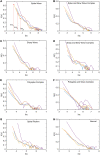Distinguishing Epileptiform Discharges From Normal Electroencephalograms Using Scale-Dependent Lyapunov Exponent
- PMID: 33015003
- PMCID: PMC7506120
- DOI: 10.3389/fbioe.2020.01006
Distinguishing Epileptiform Discharges From Normal Electroencephalograms Using Scale-Dependent Lyapunov Exponent
Abstract
Epileptiform discharges are of fundamental importance in understanding the physiology of epilepsy. To aid in the clinical diagnosis, classification, prognosis, and treatment of epilepsy, it is important to develop automated computer programs to distinguish epileptiform discharges from normal electroencephalogram (EEG). This is a challenging task as clinically used scalp EEG often contains a lot of noise and motion artifacts. The challenge is even greater if one wishes to develop explainable rather than black-box based approaches. To take on this challenge, we propose to use a multiscale complexity measure, the scale-dependent Lyapunov exponent (SDLE). We analyzed 640 multi-channel EEG segments, each 4 s long. Among these segments, 540 are short epileptiform discharges, and 100 are from healthy controls. We found that features from SDLE were very effective in distinguishing epileptiform discharges from normal EEG. Using Random Forest Classifier (RF) and Support Vector Machines (SVM), the proposed approach with different features from SDLE robustly achieves an accuracy exceeding 99% in distinguishing epileptiform discharges from normal control ones. A single parameter, which is the ratio of the spectral energy of EEG signals and the SDLE and quantifies the regularity or predictability of the EEG signals, is introduced to better understand the high accuracy in the classification. It is found that this regularity is considerably greater for epileptiform discharges than for normal controls. Robustly having high accuracy in distinguishing epileptiform discharges from normal controls irrespective of which classification scheme being used, the proposed approach has the potential to be used widely in a clinical setting.
Keywords: EEG; epileptiform discharges; power spectral density (PSD); random forest classifier; scale-dependent Lyapunov exponent (SDLE); support vector machine (SVM).
Copyright © 2020 Li, Gao, Huang, Wu and Xu.
Figures









Similar articles
-
Distinguishing Epileptiform Discharges From Normal Electroencephalograms Using Adaptive Fractal and Network Analysis: A Clinical Perspective.Front Physiol. 2020 Aug 5;11:828. doi: 10.3389/fphys.2020.00828. eCollection 2020. Front Physiol. 2020. PMID: 32903770 Free PMC article.
-
Multiscale analysis of biological data by scale-dependent lyapunov exponent.Front Physiol. 2012 Jan 24;2:110. doi: 10.3389/fphys.2011.00110. eCollection 2011. Front Physiol. 2012. PMID: 22291653 Free PMC article.
-
EEG CLassification Via Convolutional Neural Network-Based Interictal Epileptiform Event Detection.Annu Int Conf IEEE Eng Med Biol Soc. 2018 Jul;2018:3148-3151. doi: 10.1109/EMBC.2018.8512930. Annu Int Conf IEEE Eng Med Biol Soc. 2018. PMID: 30441062 Free PMC article.
-
Cortical substrates of scalp EEG epileptiform discharges.J Clin Neurophysiol. 2007 Apr;24(2):96-100. doi: 10.1097/WNP.0b013e31803ecdaf. J Clin Neurophysiol. 2007. PMID: 17414965 Review.
-
Effects of epileptiform EEG discharges on cognitive function: is the concept of "transient cognitive impairment" still valid?Epilepsy Behav. 2004 Feb;5 Suppl 1:S25-34. doi: 10.1016/j.yebeh.2003.11.005. Epilepsy Behav. 2004. PMID: 14725844 Review.
Cited by
-
NoLiTiA: An Open-Source Toolbox for Non-linear Time Series Analysis.Front Neuroinform. 2022 Jun 24;16:876012. doi: 10.3389/fninf.2022.876012. eCollection 2022. Front Neuroinform. 2022. PMID: 35811996 Free PMC article.
-
Multi-Threshold Recurrence Rate Plot: A Novel Methodology for EEG Analysis in Alzheimer's Disease and Frontotemporal Dementia.Brain Sci. 2024 Jun 1;14(6):565. doi: 10.3390/brainsci14060565. Brain Sci. 2024. PMID: 38928565 Free PMC article.
-
EEG Microstate Features as an Automatic Recognition Model of High-Density Epileptic EEG Using Support Vector Machine.Brain Sci. 2022 Dec 17;12(12):1731. doi: 10.3390/brainsci12121731. Brain Sci. 2022. PMID: 36552190 Free PMC article.
References
-
- Anh-Dao N. T., Linh-Trung N., Van Nguyen L., Tran-Duc T., Boashash B. (2018). A multistage system for automatic detection of epileptic spikes. Rev J. Electron. Commun. 8, 1–12. 10.21553/rev-jec.166 - DOI
-
- Antoniades A., Spyrou L., Took C. C., Sanei S. (2016). Deep learning for epileptic intracranial EEG data, in Deep learning International Workshop on Machine Learning for Signal Processing (MLSP) (Vietri sul Mare: ), 1–6. 10.1109/MLSP.2016.7738824 - DOI
-
- Arunkumar N., Ram Kumar K., Venkataraman V. (2016). Automatic detection of epileptic seizures using permutation entropy, Tsallis entropy and Kolmogorov complexity. J. Med. Imaging Health Inform. 6, 526–531. 10.1166/jmihi.2016.1710 - DOI
LinkOut - more resources
Full Text Sources

